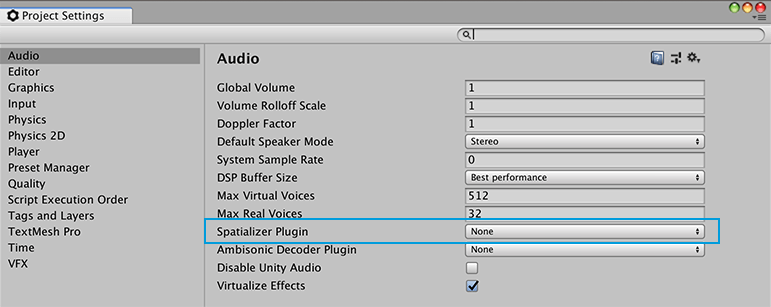Audio Spatializers
Audio spatializers use “physical” characteristics of a sceneA Scene contains the environments and menus of your game. Think of each unique Scene file as a unique level. In each Scene, you place your environments, obstacles, and decorations, essentially designing and building your game in pieces. More info
See in Glossary, such as the distance and angle between an AudioListener and an AudioSource, to modify the properties of sound transmitted to the user. Spatialization can improve the perception that a sound originates from a specific location in a scene.
The Unity audio engine supports spatialization through plug-insA set of code created outside of Unity that creates functionality in Unity. There are two kinds of plug-ins you can use in Unity: Managed plug-ins (managed .NET assemblies created with tools like Visual Studio) and Native plug-ins (platform-specific native code libraries). More info
See in Glossary built with the Unity Audio Spatializer SDK. Unity does not provide any built-in spatializer plug-ins itself, but several plug-in implementations are available in third-party 3D audio SDKs. These audio SDKs typically provide additional Unity components and tools for 3D audio.
The following is a non-comprehensive list of third-party audio SDKs that provide Unity audio spatialization plug-ins:
| Maker | Name | Platforms | Documentation |
|---|---|---|---|
| Microsoft | Microsoft Spatializer | Windows, Android | https://learn.microsoft.com/en-us/windows/mixed-reality/develop/unity/spatial-sound-in-unity |
| Oculus | Oculus Spatializer Unity | Windows, Android | https://developer.oculus.com/documentation/unity/unity-audio/ |
| Qualcomm | Qualcomm 3D Audio Plugin for Unity | Windows, Android | https://developer.qualcomm.com/software/3d-audio-plugin-unity |
| Steam | Steam Audio | Windows, MacOS, Linux, Android | https://valvesoftware.github.io/steam-audio/doc/unity/index.html |
| Vive | 3DSP Audio SDK | Windows, Android | https://hub.vive.com/storage/3dsp/ |
| Google (now open source) | Resonance Audio | Android, iOS, Web |
In some cases, spatializer plug-ins are included with the XR provider plug-in for an associated XRAn umbrella term encompassing Virtual Reality (VR), Augmented Reality (AR) and Mixed Reality (MR) applications. Devices supporting these forms of interactive applications can be referred to as XR devices. More info
See in Glossary device. For example, the Oculus provider plug-in includes the OculusSpatializer plug-in and the Windows Mixed RealityMixed Reality (MR) combines its own virtual environment with the user’s real-world environment and allows them to interact with each other.
See in Glossary feature group for OpenXR includes the MS HRTF Spatializer plug-in. Note that these provider plug-ins do not include any additional components that might be available in the full SDK packages from their maker.
Note: Although many spatializer plug-ins were developed for use with VRVirtual Reality More info
See in Glossary devices, their use is not limited to VR games or applications.
Enable an audio spatializer plug-in
After you have added the package containing an audio spatializerA plug-in that changes the way audio is transmitted from an audio source into the surrounding space. It takes the source and regulates the gains of the left and right ear contributions based on the distance and angle between the AudioListener and the AudioSource. More info
See in Glossary plug-in to your project, you can enable the plug-in in the project audio settings.
To enable a plug-in:
- Open the Project Settings window (menu: Edit > Project Settings).
- Select the Audio category.
- Choose the plug-in from the Spatializer Plugin dropdown menu.
